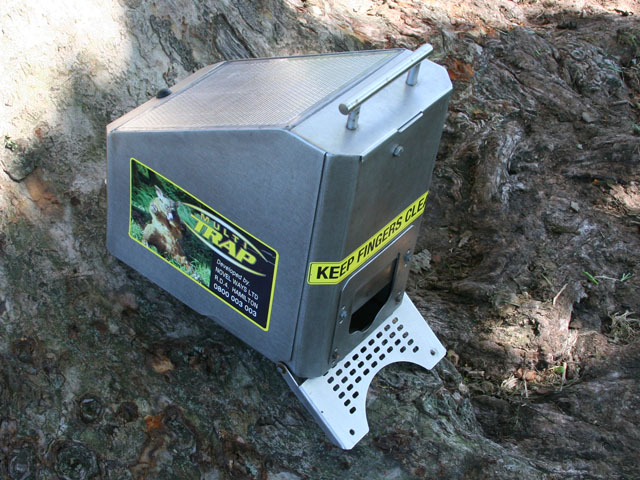
Possum & Pest Trap
Dealing with the Possum problem on farms
Possums generally affect farmers with bush or scrub boundaries because these conditions are perfect for their survival. The bush offers some of their normal native plant and insects diet, but they prefer to den near to the grassy areas of the farm.
During autumn and winter, they will travel up to 1200 meters from within the bush to eat grass, creating characteristic possum tracks through the pasture with these movements. It seems likely that at least 50% of their intake during low pasture growth times of the year will be grass (they prefer clover), and this is around 80 grams of dry matter per animal per day. As an example, 50Ha (effective) of bush adjacent to a farm could hold about 750 possums (up to 30 per hectare), and these would consume as much grass as 12 dried-off cows.
To make up the other 50% of their food intake, they will also seek out shelter belt trees; willows, roses, orchard fruit, forage crops (swede etc), young pine trees and cones, and the fruit and foliage of fast-growing and/or soft leaved native species (wineberry, fuschia, pohutakawa, rata, kohekohe, five-finger, etc.)
In areas of dense possum population like the above example, a Tb-carrying possum could infect other possums in the area. Young males travel up to 25km from their place of birth to re-establish. They share and swap dens, and it's probable that the infection is passed in this way. Some possums live for years with the infection, and a proportion of any possums found dead in pasture near Tb hotspots will have Tb. Any stock mouthing or inspecting these animals may in turn contract Tb, but the main reservoir of the infection appears to be in the possum population.
Suggested Action
Farmers can increase production on farms like those in the above example by regularly culling all possums near their boundaries (possum populations in such areas can regenerate in 4-5 years, helped by migration). The risk of Tb is also lowered by possum culling. Always remove all possum carcasses from areas that can be accessed by stock; preferably burn or bury them.
There will be other benefits with improved shelter belts, forestry plantations, forage crop harvests, and the ability to plant specimen trees around the farm without risking damage by possums.
Our Electronic Trap - The MultiTrap
The automatic trap that Novel Ways staff have designed is based on the research findings that we are aware of, combined with our knowledge of the possum problem. It uses the type of technology that we are familiar with, being electronic and compact. It is designed to require very little input, say checking once every month or so, and will try to remove possums from a 20Ha surrounding area every night. It can play possum vocalisations, dispenses jam or liquid bait, works using the standard choking method, and is a completely self-resettable kill trap. It records data on catches, and suits a sloping or raised position, using gravity to drop possums some distance from the trap. The electronic control board allows the trap to reduce its aperture size and catching method automatically, to target mustelids and rats.
As it runs on solar power, it is perfect for bush margins near farms, and there it will have the greatest effect on reducing Tb incidences in stock. If funding allows, we will continue design refinements and site testing, and hope to bring a device like this to the market. At this stage we hope to match the costs/Ha of poisoning and trapping methods, which means each trap will cost $800, but has very low maintenance expenses. In one trial, 50 possum were taken out over a 35 day period, using one trap mounted on the same tree.
We gratefully acknowledge the support given to our research by the Foundation for Research and Science and Technology, in funding us for three TIF undergraduates and approving us for a GPSRD project on the trap; all from Technology New Zealand.
